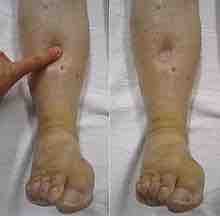Edema
Edema is an abnormal accumulation of fluid beneath the skin or in one or more cavities of the body that produces swelling. Edema is caused by increased secretion of fluid into the interstitium or impaired removal of this fluid.
Cutaneous edema is referred to as pitting when, after pressure is applied to a small area, the indentation persists for some time after the release of the pressure. Peripheral pitting edema, as shown in , is the more common type, resulting from water retention. It can be caused by systemic diseases, pregnancy in some women, either directly or as a result of heart failure, or local conditions such as varicose veins, thrombophlebitis, insect bites, and dermatitis. Non-pitting edema is observed when the indentation does not persist. It is associated with such conditions as lymphedema, lipoedema, and myxedema.

Peripheral pitting edema
Peripheral pitting edema results from water retention. It can be caused by systemic diseases, pregnancy in some women, and as a result of heart failure or varicose veins.
Edema may also occur as a result of cardiac failure due to the rise in hydrostatic pressure. A fall in osmotic pressure occurs in nephrotic syndrome and liver failure, and may cause edema.
Causes of edema which are generalized to the whole body can cause edema in multiple organs and peripherally. For example, severe heart failure can cause pulmonary edema, pleural effusions, ascites, and peripheral edema.
As well as the previously mentioned conditions, edemas often occur during the late stages of pregnancy in some women. Edema is more common with those of a history of pulmonary problems or poor circulation, and may be affected by the presence of arthritis. Edemas that occur during pregnancy are usually found in the lower part of the leg, usually from the calf down.
Edema will occur in specific organs as part of inflammations, tendinitis, or pancreatitis, for instance. Certain organs develop edema through tissue specific mechanisms. Examples of edema in specific organs include cerebral edema, pulmonary edema, periorbital edema (eye puffiness), and cutaneous edema due to mosquito bites, spider bites, bee stings, or contact dermatitis). Another cutaneous form of edema is myxedema, which is caused by increased deposition of connective tissue. In myxedema edema is caused by an increased tendency of the tissue to hold water within its extracellular space. In myxedema this is because of an increase in hydrophilic carbohydrate-rich molecules (perhaps mostly hyaluronan) deposited in the tissue matrix.